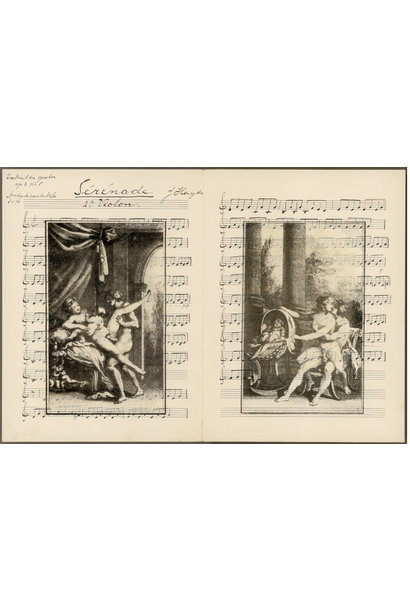

Heather Passmore “Enlightenment”, Heather Passmore
C$ 0.00 Excl. tax
- File number: EXHI1041
...
Between 1750 and 1850, there was a sudden interest in the illicit nature of pornographic representation throughout Europe. One reason for this was the discovery and unearthing of Pompeii and Herculaneum in 1748, two ancient cities buried under ash and mud in the wake of Vesuvius’ eruption in 79 A.D. Within the cities’ structures archeologists found frescos of copulating couples, marble statues of penetrating pans, and terracotta wingéd priapi, adorning these ancient homes. Because 17th and 18th-century eyes found these artifacts to be indecent, they were locked away in a secret museum in Naples, and their viewing was restricted to only a few archeologists, historians, and elite gentlemen. It is believed that, in ancient times, these lewd images and objects brought good luck to those who displayed them in their homes, acting as safeguards for human and agricultural fertility. But ultimately these erotic images and objects demonstrate how the citizens of Pompeii and Herculaneum possessed a healthy and lively sense of humour. To those discovering this erotic treasure centuries later, such an open display of sexual activity was shocking, as it was thought to lead to immoral social behaviour. However, for these first century inhabitants such erotica was celebrated as natural and pleasurable. It is believed that the discovery of these long lost artifacts at Pompeii and Herculaneum was seminal in enflaming over two centuries of discourse around, and accelerated production of, pornography.
Heather Passmore’s Enlightenment is a suite of photolithographic prints, in which 18th-century pornographic imagery is printed on antique hand-notated sheet music. What to make of the dominance of priapi and putti? A priapus is either at the centre of a ring of dancing putto, being straddled by a woman reading a book while it ejaculates with joy, or is simply flying up a woman’s dress toward her genitals, having sprouted bird or butterfly wings. Priapi are phalluses, but they are originally rooted in the figure of Priapus, an ancient Greek fertility god, protector not only of the male genitals, but also all matters agricultural, including gardens, crops, and livestock. Over time it was used to name exaggeratedly enlarged erect penises, usually detached from the male body proper. Putti appear prominently in Renaissance, Baroque, and Rococo art as chubby winged toddlers, and serve as symbols of love and passion but originally seem to have served as Greco-Roman representations of a guardian spirit. While they were on the wane in the high art of the Enlightenment, they continued to serve their erotic function in 18th century pornography, a holdover of the frivolity and lasciviousness of the Rococo style. The putto’s association with cherubim and cupids make for confusing symbolism, at once secular and divine. Unlike most pornography today, which tends to debase the body toward the instrumental aim of orgasm, these lovingly drawn images appear not only to titillate, but also to ground sexuality in the agency of female pleasure and fertility. Putti usually figure as babies, no older than a year or so, and while theatrically decorative, they are almost always represented as being helpful. The two instances where a woman is being penetrated by a man show her tending to her infant, either breastfeeding or rocking the crib. In this day and age, the presence of an infant in the vicinity of fornication would be considered beyond the pale. The other images in Passmore’s suite show women dancing about with these detached phalluses, men pleasuring women through acts of cunnilingis and masturbation. Women are in control of their sexuality, wholly. They are agents of pleasure, and not just passive receivers. There is a curious image of the nine muses playing with dildos, one even playing a harp made with two erect phalluses; when a man is present, it is to pleasure her without interference of his own member. In another print, cupid as a young boy points a bow and dildo, as well as his own engorged penis, at a young woman in bedclothes with a decidedly swollen belly. These prints prove pregnant in their poetic and erotic implications, and prick us with an anachronistic ribaldry, compared to most contemporary portrayals of sex.
As mentioned, these 18th-century erotic images are printed on hand-notated sheet music, mostly of Joseph Haydn’s Serenade, string quartet, opus 3, no. 5. The dangling notes arranged on horizontal staves, speak to a durational potency. Without the instruments playing in real time however, the music remains only virtually sonorous. This allows for the rhythmic sexualized bodies to take over, filling the pages with a purely visual thrust. For those familiar with Haydn’s string quartet, like all serenade music, it could be characterized as light and calm, even blissful. Although serenades are honorific, most are associated with wooing a prospective mate. Perhaps aristocratic secret lovers glanced at one another from across the room at a salon or private concert, while listening to Haydn’s serenade. While there is no real association with love in the music itself, the word ‘serenade’ repeated on the sheet music on which the erotic imagery is printed, resonates as libidinal. The presence of ornament and opulent settings in the images themselves speak to the aristocratic patronage that Haydn would have been surrounded by while seeking all manner of patronage as a young man. It also speaks to Haydn the adulterer, speaking to his pursuit of an active sex-life despite the moral standards of his time.
While we are limited to our enjoyment of these prints in the gallery, it is important to mention one more branch of the project, related to social transgression. Passmore had expanded her project into the public realm through stenciling a cupid riding a phallus and a phallus with butterfly wings on a ground of milk-paint, graffito-style. These gestures bring us back to the spirit of public displays of erotic pleasure in Pompeii and Herculaneum. Unfortunately for we erotic-art appreciators with a healthy sense of humour, the Passmore’s gesture was promptly removed to return the bare concrete walls and beams to pubic propriety.
Marina Roy
Heather Passmore is a contemporary artist based in Vancouver, Canada. For the past ten years she has exhibited extensively in major solo and group exhibitions across Canada and internationally. Her practice reconfigures painting, drawing, printmaking and photography with a variety of socio-historically laden materials. Heather’s artwork frequently intersects social justice issues using materials which bear histories of taste and accumulations of labour. These have included illegal milk from community supported agriculture, linoleum from demolished Vancouver real estate, abandoned mattresses and art world form letters.
Heather obtained an MFA from the University of British Columbia. She frequently conducts artist talks at universities and galleries. Her critical essays and reviews have been published locally. Heather has been awarded a number of project assistance grants from the BC Arts Council and the Canada Council for the Arts and she has received several contemporary art prizes. Heather has completed numerous international artist residencies and public artworks at home and abroad. Her work is held in both private and official public collections such as the Vancouver Art Gallery.
Special thanks to Val Loewen for her collaboration in printing the work in this exhibition.
Recently viewed
-
 Favoriten
Add to cart
Favoriten
Add to cart
Heather Passmore “Enlightenment”, Heather Passmore
C$ 0.00 Excl. tax


